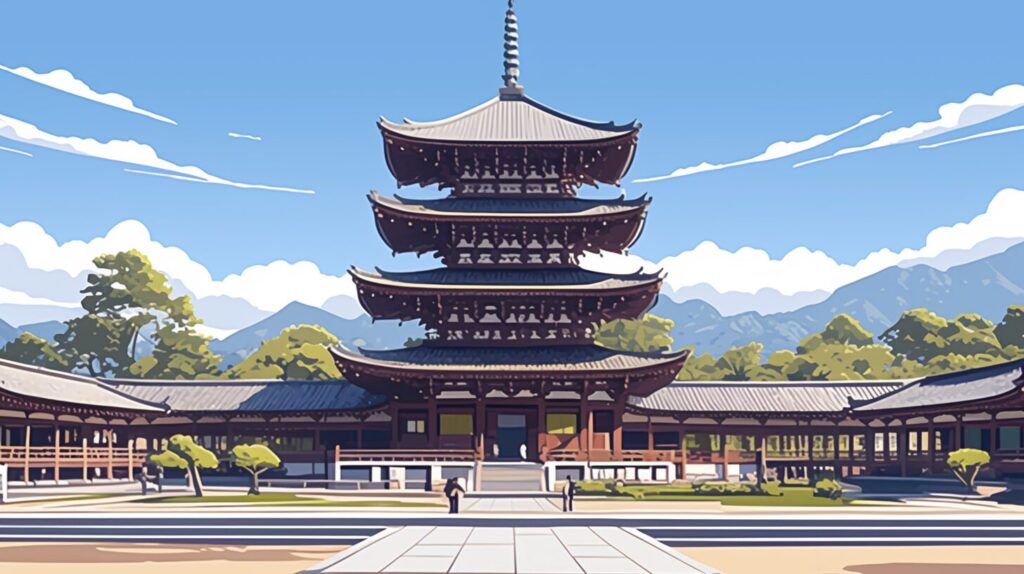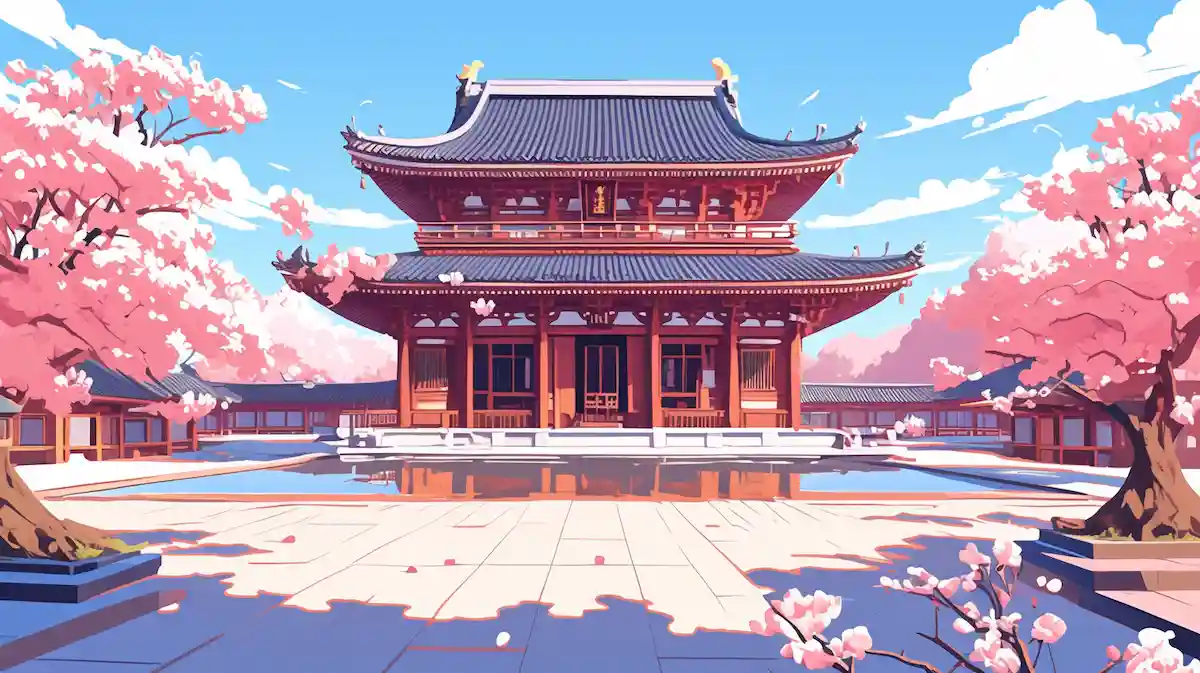薬師寺を英語で説明・紹介するための基本情報と、英会話に役立つ表現をシンプルでわかりやすい英語で紹介します。
英会話ダイアローグ・概要・10の質問を通して、薬師寺に関する英語表現を学びます。
英語
英会話ダイアローグを読む前に知っておくと良い前提知識と情報です。
- 薬師寺の基本情報
- 680年創建の天武天皇が皇后の病気平癒を祈って建てた寺院
- ユネスコ世界遺産「古都奈良の文化財」の一部に登録されている
- 薬師寺の見どころ
- 東塔: 1300年以上の歴史を持つ国宝ら三重塔だが裳階(もこし)が付いており、六重に見える独特なデザイン
- 西塔: 1998年に再建され、東塔とともに美しい対称性を作り出している
- 金堂(本堂): 薬師三尊像(薬師如来と日光・月光菩薩)が安置されている
- 玄奘三蔵院: 「西遊記」のモデルとなった玄奘三蔵を祀る伽藍
- 庭園: 四季折々の美しさを楽しめ、桜や紅葉が特に有名
- 薬師寺での体験
- 写経体験: 仏教経典を写しながら心を落ち着ける活動
- 夜間ライトアップ: 季節限定で行われる幻想的なイベント
2人が薬師寺について話しています。
薬師寺の歴史、東塔と西塔の特徴、薬師三尊像、写経体験などを話題にしています。
会話 / dialogue

Key, I’ve heard a lot about Yakushiji Temple recently. It seems so fascinating. Have you ever been there?

Yeah, I visited last spring during the cherry blossom season. It’s incredible, Mack. Are you planning to go?

I’m thinking about it. But first, I want to know more. What makes Yakushiji so special?

Well, for starters, it’s one of Nara’s most famous temples and part of a UNESCO World Heritage Site. It was originally built in 680 by Emperor Tenmu to pray for his wife’s health.

That’s so interesting. And it’s over 1,300 years old?

That’s right. Although it was initially built in Fujiwara-kyo, it was moved to Nara in 710 when the capital shifted.

I read something about twin pagodas. Is that true?

Absolutely. Yakushiji’s layout is unique because of the twin pagodas – the East Pagoda and the West Pagoda. The East Pagoda is the original structure, and it’s a National Treasure.

What’s so special about the East Pagoda?

It’s famous for its design. It looks like it has six stories, but it actually has three with small roofs in between, called mokoshi. An art historian, Ernest Fenollosa, even called it “frozen music.”

That sounds amazing! What about the West Pagoda?

The West Pagoda was reconstructed in 1998 to match the original twin-pagoda design. Together, they create a beautiful symmetry.

What’s inside the temple?

The main hall, called Kondo, houses the Yakushi Triad – a stunning set of statues featuring Yakushi Nyorai, the Medicine Buddha, and two Bodhisattvas, Nikko and Gakko.

I’d love to see that! Are there any other highlights?

Definitely. There’s the Great Lecture Hall for Buddhist ceremonies, and the Genjo Sanzo-in, which honors Xuanzang, the Chinese monk who inspired Journey to the West.

Oh, that’s really cool! Can visitors do anything hands-on?

Yes! You can try sutra copying. It’s a peaceful activity where you write Buddhist scriptures. It’s open to everyone, even beginners.

That sounds like a great experience. Is the temple beautiful all year round?

Totally. The gardens are stunning in every season. Cherry blossoms in spring and autumn leaves are particularly beautiful. Sometimes they even have night illuminations.

It sounds like a perfect mix of history, art, and nature. How do I get there?

It’s super convenient. Yakushiji is just a one-minute walk from Nishinokyo Station on the Kintetsu Line.

Thanks, Key. I’m definitely going to visit soon. Maybe I’ll even try sutra copying while I’m there.

You should. I’m sure you’ll love it. Let me know how it goes!
概要 / Overview
「薬師寺」について、理解を深めるための「英語での概要」です。
薬師寺

Introduction to Yakushiji
Yakushiji is one of the most famous Buddhist temples in Nara, Japan. It was originally built in 680 by Emperor Tenmu to pray for his wife’s health. In 710, the temple was moved to its current location in Nara when the capital of Japan was relocated. Today, Yakushiji is a UNESCO World Heritage Site and attracts many visitors who are interested in history, culture, and spirituality.
Unique Layout and Twin Pagodas
The temple is famous for its twin-pagoda layout, with two pagodas standing symmetrically on either side of the main hall (Kondo). The East Pagoda is the only remaining original structure from the 8th century and is designated as a National Treasure. It appears to have six stories but actually has three, with additional small roofs, called mokoshi. The American art historian Ernest Fenollosa praised its design and called it “frozen music,” highlighting its artistic and architectural beauty. The West Pagoda was reconstructed in 1998 and mirrors the East Pagoda, creating a stunning symmetrical view.
The Yakushi Triad
Inside the main hall, visitors can find the famous Yakushi Triad statues. These include Yakushi Nyorai, the Medicine Buddha, in the center, flanked by Nikko (Sunlight) and Gakko (Moonlight) Bodhisattvas. These statues are masterpieces of Japanese Buddhist art and are symbols of healing, light, and compassion.
Other Highlights
Yakushiji offers several other attractions. The Great Lecture Hall is used for Buddhist ceremonies and cultural events. Another fascinating feature is the Genjo Sanzo-in, a hall dedicated to Xuanzang, a Chinese monk whose journey to India inspired the classic tale Journey to the West. The temple grounds are surrounded by beautiful gardens that change with the seasons, featuring cherry blossoms in spring and colorful leaves in autumn.
Activities for Visitors
Visitors can participate in sutra copying, a peaceful activity where they write Buddhist scriptures. This tradition is open to everyone, even beginners, and offers a chance to experience Buddhist culture. Additionally, seasonal night illuminations create a magical atmosphere, making Yakushiji even more enchanting.
Conclusion
Yakushiji Temple is a blend of history, art, and spirituality. Its ancient East Pagoda, renowned Yakushi Triad, and engaging activities provide a rich cultural experience. Whether you are interested in Buddhist traditions, Japanese history, or simply a serene escape, Yakushiji is a place you should not miss.
10の質問 / 10 questions
「薬師寺」について、理解を深めるための「英語での10の質問」です。
1: What is Yakushiji?
Yakushiji is a historic Buddhist temple located in Nara, Japan. It was built in 680 by Emperor Tenmu to pray for his wife’s health and is now a UNESCO World Heritage Site.
2: Why is Yakushiji famous?
Yakushiji is famous for its twin-pagoda layout, with the East Pagoda being an original 8th-century structure and a National Treasure.
3: What is special about the East Pagoda?
The East Pagoda appears to have six stories but actually has three, with extra small roofs called mokoshi. It was called “frozen music” by art historian Ernest Fenollosa because of its beauty.
4: What are the Yakushi Triad statues?
The Yakushi Triad includes Yakushi Nyorai, the Medicine Buddha, in the center, flanked by two Bodhisattvas, Nikko (Sunlight) and Gakko (Moonlight).
5: What can visitors do at Yakushiji?
Visitors can try sutra copying, a peaceful activity where they write Buddhist scriptures, and enjoy seasonal night illuminations.
6: When was Yakushiji moved to its current location?
Yakushiji was moved to Nara in 710 when the capital of Japan was relocated from Fujiwara-kyo.
7: What is the West Pagoda?
The West Pagoda was reconstructed in 1998 to match the design of the East Pagoda, creating a symmetrical view.
8: Who is honored in the Genjo Sanzo-in?
The Genjo Sanzo-in honors Xuanzang, a Chinese monk whose journey to India inspired the story Journey to the West.
9: What seasons are best to visit Yakushiji?
Spring and autumn are the best seasons to visit Yakushiji, as the cherry blossoms and colorful leaves make the gardens especially beautiful.
10: How can visitors reach Yakushiji?
Yakushiji is very convenient to access, located just a one-minute walk from Nishinokyo Station on the Kintetsu Line.

和訳付
会話 / dialogue

Key, I’ve heard a lot about Yakushiji Temple recently. It seems so fascinating. Have you ever been there?
キー、最近薬師寺についてよく耳にするんだ。とても魅力的だよね。行ったことある?

Yeah, I visited last spring during the cherry blossom season. It’s incredible, Mack. Are you planning to go?
うん、去年の春、桜の季節に行ったよ。素晴らしかったよ、マック。行くつもり?

I’m thinking about it. But first, I want to know more. What makes Yakushiji so special?
考えてるんだけど、まずもっと知りたいな。薬師寺が特別な理由は何?

Well, for starters, it’s one of Nara’s most famous temples and part of a UNESCO World Heritage Site. It was originally built in 680 by Emperor Tenmu to pray for his wife’s health.
まず、奈良で最も有名な寺院の一つで、ユネスコの世界遺産に登録されているんだ。元々は680年に天武天皇が皇后の健康を祈って建てたんだよ。

That’s so interesting. And it’s over 1,300 years old?
それは面白いね。それで1300年以上も前のものなの?

That’s right. Although it was initially built in Fujiwara-kyo, it was moved to Nara in 710 when the capital shifted.
その通り。最初は藤原京に建てられたんだけど、710年に都が移るときに奈良に移されたんだ。

I read something about twin pagodas. Is that true?
双塔のことを読んだことがあるけど、それって本当?

Absolutely. Yakushiji’s layout is unique because of the twin pagodas – the East Pagoda and the West Pagoda. The East Pagoda is the original structure, and it’s a National Treasure.
もちろん。本当にユニークで、東塔と西塔という双塔があるんだ。東塔は創建当時から残っている建物で、国宝に指定されているよ。

What’s so special about the East Pagoda?
東塔の何がそんなに特別なの?

It’s famous for its design. It looks like it has six stories, but it actually has three with small roofs in between, called mokoshi. An art historian, Ernest Fenollosa, even called it “frozen music.”
デザインが有名なんだ。六重に見えるけど、実際には三重で、間に「裳階」と呼ばれる小さな屋根が付いているんだ。美術史家のアーネスト・フェノロサは「凍れる音楽」とまで称賛したよ。

That sounds amazing! What about the West Pagoda?
すごいね!西塔はどうなの?

The West Pagoda was reconstructed in 1998 to match the original twin-pagoda design. Together, they create a beautiful symmetry.
西塔は1998年に再建されて、双塔のデザインを再現しているんだ。二つが揃って美しい対称性を作り出しているよ。

What’s inside the temple?
寺の中には何があるの?

The main hall, called Kondo, houses the Yakushi Triad – a stunning set of statues featuring Yakushi Nyorai, the Medicine Buddha, and two Bodhisattvas, Nikko and Gakko.
金堂という本堂には薬師三尊像が安置されているんだ。薬師如来(薬師仏)と二人の菩薩、日光菩薩と月光菩薩の美しい仏像だよ。

I’d love to see that! Are there any other highlights?
それはぜひ見たいな!他に見どころはある?

Definitely. There’s the Great Lecture Hall for Buddhist ceremonies, and the Genjo Sanzo-in, which honors Xuanzang, the Chinese monk who inspired Journey to the West.
もちろん。仏教儀式のための大講堂や、中国の僧侶・玄奘を祀った玄奘三蔵院があるよ。「西遊記」のモデルになった人物なんだ。

Oh, that’s really cool! Can visitors do anything hands-on?
それはすごく面白いね!訪問者が体験できることってある?

Yes! You can try sutra copying. It’s a peaceful activity where you write Buddhist scriptures. It’s open to everyone, even beginners.
あるよ!写経体験ができるんだ。仏教の経典を書き写す静かな活動で、初心者でも気軽に参加できるよ。

That sounds like a great experience. Is the temple beautiful all year round?
素晴らしい体験になりそうだね。寺は一年中美しいの?

Totally. The gardens are stunning in every season. Cherry blossoms in spring and autumn leaves are particularly beautiful. Sometimes they even have night illuminations.
完全にそうだね。庭園はどの季節でも素晴らしいよ。特に春の桜や秋の紅葉は美しい。夜間ライトアップが行われることもあるんだ。

It sounds like a perfect mix of history, art, and nature. How do I get there?
歴史、芸術、自然が完璧に混ざり合ってる感じだね。どうやって行けばいい?

It’s super convenient. Yakushiji is just a one-minute walk from Nishinokyo Station on the Kintetsu Line.
すごく便利だよ。近鉄線の西ノ京駅から徒歩1分なんだ。

Thanks, Key. I’m definitely going to visit soon. Maybe I’ll even try sutra copying while I’m there.
ありがとう、キー。近いうちに絶対行ってみるよ。写経もやってみようかな。

You should. I’m sure you’ll love it. Let me know how it goes!
ぜひ!絶対気に入ると思うよ。どうだったか教えてね!
概要 / Overview
薬師寺

Introduction to Yakushiji
Yakushiji is one of the most famous Buddhist temples in Nara, Japan. It was originally built in 680 by Emperor Tenmu to pray for his wife’s health. In 710, the temple was moved to its current location in Nara when the capital of Japan was relocated. Today, Yakushiji is a UNESCO World Heritage Site and attracts many visitors who are interested in history, culture, and spirituality.
薬師寺は、奈良県にある最も有名な仏教寺院の一つです。680年に天武天皇が皇后の病気平癒を祈るために創建しました。710年に日本の首都が奈良に遷都された際、現在の場所に移されました。現在、薬師寺はユネスコの世界遺産に登録され、歴史や文化、精神性に興味のある多くの訪問者を引きつけています。
Unique Layout and Twin Pagodas
The temple is famous for its twin-pagoda layout, with two pagodas standing symmetrically on either side of the main hall (Kondo). The East Pagoda is the only remaining original structure from the 8th century and is designated as a National Treasure. It appears to have six stories but actually has three, with additional small roofs, called mokoshi. The American art historian Ernest Fenollosa praised its design and called it “frozen music,” highlighting its artistic and architectural beauty. The West Pagoda was reconstructed in 1998 and mirrors the East Pagoda, creating a stunning symmetrical view.
薬師寺は、双塔式の伽藍配置で有名です。二つの塔が金堂の両側に対称的に立っています。東塔は8世紀から現存する唯一の建物で、国宝に指定されています。一見すると六重塔に見えますが、実際には裳階(もこし)と呼ばれる小さな屋根を含む三重塔です。アメリカの美術史家アーネスト・フェノロサはそのデザインを絶賛し、「凍れる音楽」と表現しました。1998年に再建された西塔は、東塔を鏡のように映し出し、美しい対称性を生み出しています。
The Yakushi Triad
Inside the main hall, visitors can find the famous Yakushi Triad statues. These include Yakushi Nyorai, the Medicine Buddha, in the center, flanked by Nikko (Sunlight) and Gakko (Moonlight) Bodhisattvas. These statues are masterpieces of Japanese Buddhist art and are symbols of healing, light, and compassion.
金堂の中には、有名な薬師三尊像が安置されています。この三尊像は、中央に薬師如来(薬師仏)、両脇に日光菩薩と月光菩薩が並んでいます。これらの仏像は日本仏教美術の最高傑作の一つであり、癒し、光、慈悲を象徴しています。
Other Highlights
Yakushiji offers several other attractions. The Great Lecture Hall is used for Buddhist ceremonies and cultural events. Another fascinating feature is the Genjo Sanzo-in, a hall dedicated to Xuanzang, a Chinese monk whose journey to India inspired the classic tale Journey to the West. The temple grounds are surrounded by beautiful gardens that change with the seasons, featuring cherry blossoms in spring and colorful leaves in autumn.
薬師寺には他にも見どころがあります。大講堂では仏教儀式や文化イベントが行われます。また、玄奘三蔵院は、中国の僧侶・玄奘三蔵を祀った建物で、彼のインドへの旅は『西遊記』の物語のモデルとなりました。境内は美しい庭園に囲まれており、春の桜や秋の紅葉など、季節ごとの景色が楽しめます。
Activities for Visitors
Visitors can participate in sutra copying, a peaceful activity where they write Buddhist scriptures. This tradition is open to everyone, even beginners, and offers a chance to experience Buddhist culture. Additionally, seasonal night illuminations create a magical atmosphere, making Yakushiji even more enchanting.
訪問者は写経体験に参加することができます。これは仏教の経典を書き写す静かな活動で、初心者でも気軽に参加できます。また、季節限定の夜間ライトアップでは、幻想的な雰囲気を楽しむことができ、薬師寺の魅力をさらに引き立てます。
Conclusion
Yakushiji Temple is a blend of history, art, and spirituality. Its ancient East Pagoda, renowned Yakushi Triad, and engaging activities provide a rich cultural experience. Whether you are interested in Buddhist traditions, Japanese history, or simply a serene escape, Yakushiji is a place you should not miss.
薬師寺は、歴史、芸術、精神性が融合した場所です。古代の東塔、名高い薬師三尊像、そして体験型の活動が豊かな文化体験を提供します。仏教の伝統や日本の歴史に興味がある人や、静かな癒しを求めている人にとって、薬師寺は見逃せない場所です。
10の質問 / 10 questions
1: What is Yakushiji?
薬師寺とは何ですか?
Yakushiji is a historic Buddhist temple located in Nara, Japan. It was built in 680 by Emperor Tenmu to pray for his wife’s health and is now a UNESCO World Heritage Site.
薬師寺は日本の奈良にある歴史的な仏教寺院です。680年に天武天皇が皇后の健康を祈るために建て、現在はユネスコ世界遺産に登録されています。
2: Why is Yakushiji famous?
薬師寺はなぜ有名なのですか?
Yakushiji is famous for its twin-pagoda layout, with the East Pagoda being an original 8th-century structure and a National Treasure.
薬師寺は双塔式の伽藍配置で有名で、東塔は8世紀の建築で国宝に指定されています。
3: What is special about the East Pagoda?
東塔の何が特別なのですか?
The East Pagoda appears to have six stories but actually has three, with extra small roofs called mokoshi. It was called “frozen music” by art historian Ernest Fenollosa because of its beauty.
東塔は六重塔に見えますが、実際には三重塔で、裳階(もこし)と呼ばれる小さな屋根が特徴です。その美しさから美術史家のアーネスト・フェノロサに「凍れる音楽」と称されました。
4: What are the Yakushi Triad statues?
薬師三尊像とは何ですか?
The Yakushi Triad includes Yakushi Nyorai, the Medicine Buddha, in the center, flanked by two Bodhisattvas, Nikko (Sunlight) and Gakko (Moonlight).
薬師三尊像は、中央の薬師如来(薬師仏)と、両脇の日光菩薩と月光菩薩から成る仏像です。
5: What can visitors do at Yakushiji?
薬師寺では訪問者は何ができますか?
Visitors can try sutra copying, a peaceful activity where they write Buddhist scriptures, and enjoy seasonal night illuminations.
訪問者は写経体験を楽しんだり、季節限定の夜間ライトアップを楽しんだりできます。
6: When was Yakushiji moved to its current location?
薬師寺が現在の場所に移されたのはいつですか?
Yakushiji was moved to Nara in 710 when the capital of Japan was relocated from Fujiwara-kyo.
薬師寺は710年、日本の都が藤原京から奈良に移った際に移設されました。
7: What is the West Pagoda?
西塔とは何ですか?
The West Pagoda was reconstructed in 1998 to match the design of the East Pagoda, creating a symmetrical view.
西塔は1998年に再建され、東塔と対になるデザインで対称的な景観を作り出しています。
8: Who is honored in the Genjo Sanzo-in?
玄奘三蔵院では誰が祀られていますか?
The Genjo Sanzo-in honors Xuanzang, a Chinese monk whose journey to India inspired the story Journey to the West.
玄奘三蔵院は、中国の僧侶であり、インドへの旅が『西遊記』の物語のモデルとなった玄奘を祀っています。
9: What seasons are best to visit Yakushiji?
薬師寺を訪れるのに最適な季節はいつですか?
Spring and autumn are the best seasons to visit Yakushiji, as the cherry blossoms and colorful leaves make the gardens especially beautiful.
春と秋は薬師寺を訪れるのに最適な季節です。桜と紅葉が庭園を特に美しく彩ります。
10: How can visitors reach Yakushiji?
薬師寺へのアクセス方法は?
Yakushiji is very convenient to access, located just a one-minute walk from Nishinokyo Station on the Kintetsu Line.
薬師寺は近鉄線の西ノ京駅から徒歩1分の便利な場所にあります。

words & phrases
英会話ダイアローグと関連情報に出てきた単語・フレーズです(例文は各3つ)。

reconstruct : 動詞
意味: 再建する、再構成する。To build something again after it has been damaged or destroyed; to recreate or reorganize something.
(薬師寺の西塔が1998年に再建されたことを指す)
例文:
- The team worked hard to reconstruct the old building.
「チームは古い建物を再建するために一生懸命働きました。」 - After the earthquake, the town was slowly reconstructed.
「地震の後、その町は徐々に再建されました。」 - The historian tried to reconstruct the events of the past.
「歴史家は過去の出来事を再構成しようとしました。」
symmetry : 名詞
意味: 対称性、均整。The quality of being made up of exactly similar parts facing each other or around an axis.
(薬師寺の東塔と西塔が美しい対称性を持つことを指す)
例文:
- The butterfly’s wings have perfect symmetry.
「その蝶の羽は完全な対称性を持っています。」 - The architect designed the building with great symmetry.
「建築家は建物を非常に対称的に設計しました。」 - Nature often displays surprising symmetry, such as in flowers.
「自然は花のように驚くべき対称性を見せることがあります。」
house : 動詞
意味: 所有する、保管する、収容する。To provide space for or contain something.
(薬師三尊像が金堂に安置されていることを指す)
例文:
- The museum houses many rare artifacts.
「その博物館は多くの珍しい工芸品を収蔵しています。」 - This building houses the company’s main offices.
「この建物は会社の本社が入っています。」 - The temple houses an ancient statue of Buddha.
「その寺は古い仏像を安置しています。」
triad : 名詞
意味: 三つ組み、三人組。A group of three related people, things, or ideas.
(薬師三尊像の三尊(薬師如来、日光菩薩、月光菩薩)を指す)
例文:
- The musical piece was based on a triad of notes.
「その音楽作品は三つの音から成る三和音に基づいています。」 - The triad of leaders made the important decisions.
「三人の指導者が重要な決定を下しました。」 - The Yakushi Triad is a masterpiece of Buddhist art.
「薬師三尊像は仏教美術の傑作です。」
hands-on : 形容詞
意味: 実地の、実践的な。Involving active participation rather than just theory or observation.
(薬師寺での写経体験など、実際に行えるアクティビティを指す)
例文:
- The workshop provides a hands-on learning experience.
「そのワークショップは実践的な学習体験を提供します。」 - She prefers hands-on training rather than lectures.
「彼女は講義よりも実地訓練を好みます。」 - At Yakushiji, visitors can enjoy hands-on activities like sutra copying.
「薬師寺では写経のような実践的なアクティビティを楽しむことができます。」
